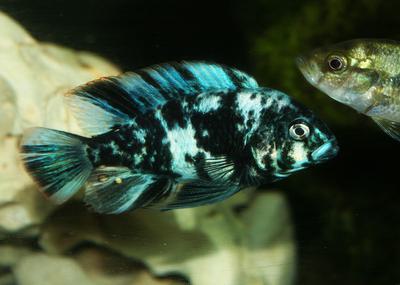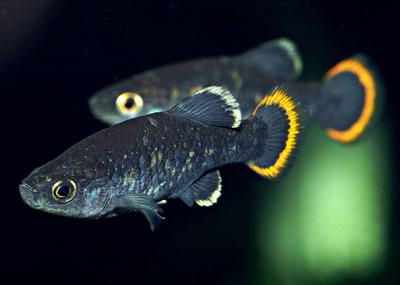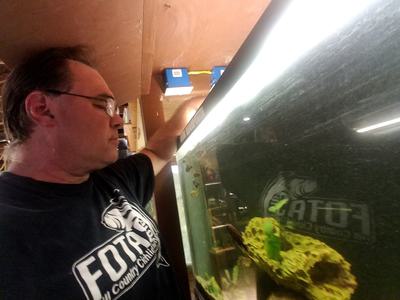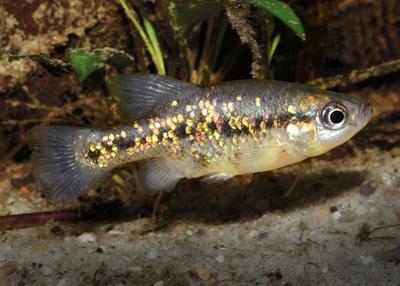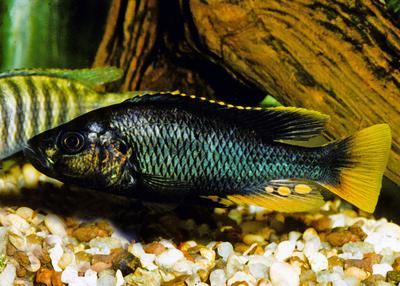Some hobby aquarists maintain hundreds of fish tanks, often in their basements because of weight and space constraints.
Freshwater fish are the most endangered group of backboned animals on the planet. Vulnerable to numerous threats including pollution, dams, mining, invasive species, and climate breakdown, they are largely ignored by big conservation groups and funders. Fish species often sink into extinction unnoticed and unnamed; a shortage of fish taxonomists means that thousands of types of fish that appear to be new species are not yet scientifically described.
At the same time, there are millions of hobby fishkeepers around the world and an industry to support them. Some hobby aquarists maintain tens or even hundreds of fish tanks, often in their basements because of weight and space constraints, and know more than academic experts about the animals they keep. A small but increasing number of these aquarists have reframed their hobby as a form of conservation and have self-organized into shoestring-budget international networks to share knowledge and fish — and to fight extinction on the home front.
Michael Koeck [center left] gives a tour of the 90 tanks he manages in the basement of the Haus des Meeres aquarium in Vienna. Credit: Jutta Kirchner
Koeck founded one of these networks, although initially for “selfish” reasons, he says. Two years after acquiring the two species of goodeids, one of them, the endearingly-named bumblebee allotoca (Allotoca dugesii), died out in his tanks. He contacted the pet shop visitor to get more, but his had died out too. “I asked him, ‘Who else has got this fish?,’ and he told me, ‘There’s no one. It was just you and me.’” Koeck was disheartened to learn that a German aquarist who had previously kept the species had given his colony to a zoo to feed to other fish “because nobody liked them.”
Koeck trawled online listservs for his lost allotoca and found other aquarists also looking for lost goodeids. Many of the sought-after fishes were in fact being kept in the hobby, but the searchers and keepers weren’t in the same online communities and weren’t finding each other. Koeck also learned that many goodeid species were rapidly being wiped out in the wild, often because Mexican agriculture’s thirst for irrigation water was drying up their habitats. This inspired Koeck and a few others to found the all-volunteer Goodeid Working Group (GWG) in 2009, based on the idea that “if you have a group of people breeding these fish, distributing these fish, then we get a chance to get these fish back,” he says. “This was the selfish start of the group, more or less.”
The GWG now coordinates about 400 hobbyists and institutions keeping at least one goodeid species each. Koeck says he realized early on that “we need to join forces, bring the professional part into the boat — the zoos, the aquariums — who work in conservation, who have the connections internationally,” together with “the big mass of private breeders who have the knowledge, the skills, the passion which is sometimes missing in a zoo.” A zookeeper who is interested in snakes, for instance, may have “no idea how to deal with goodeids, so you need goodeid breeders, fish breeders, at the beginning,” he says. Koeck’s employer, the Haus des Meeres aquarium, sponsors the upkeep of the 90 tanks of goodeids that he oversees, which now contain all described species in the family and three as-yet undescribed ones.
“The hobbyists have been more reliable than the professional institutions, in terms of keeping a species around,” says a fish biologist.
The GWG is strongly conservation-oriented. Its website collates information about all goodeid species and facilitates information and fish exchange among its members, which now span the globe. Members have regular meetings and go on self-funded field trips to the fishes’ natural habitats in Mexico. They often view their fishkeeping in moral terms, Koeck says, as a way to counteract environmental destruction. “When I’m standing in front of God I want to say ‘Not guilty! I fought back!’ or something like this.”
The GWG maintains several species that are extinct in the wild and has boosted the fortunes of some. For example, the finescale splitfin (Allodontichthys polylepis) was only scientifically described in 1988. By 2010 it was thought to be extinct in the wild and there were only eight individuals left in captivity in Europe, in a Dutch hobbyist’s tank. Koeck brought these to the Vienna bunker “ark” and began a studbook-based breeding program to retain genetic diversity. There are now about 350 individual finescale splitfins being cared for by various GWG members, and in 2016 a GWG field trip rediscovered a wild population in a Mexican river.
Enthusiastic aquarists may be good at maintaining threatened species in their tanks, but scientists caution that their efforts have limitations. Olaf Weyl, a fish ecologist at the South African Institute of Aquatic Biodiversity, says he is generally supportive of breeding rare fish in aquaria, particularly because it raises public interest in and concern for them. But often, he says, “the potential for reintroducing tank-bred fish to the wild is questionable.” Captive fish stocks can be seriously genetically bottlenecked, he says, and can evolve from wild fish into tank-adapted types over generations. He adds that captive breeding programs might encourage complacency – an African fish’s habitat may be being destroyed, for example, but people might think “it’s OK because there are thousands of them in tanks in Europe.”
A makobe (Neochromis omnicaeruleus) [left] and a tequila splitfin (Zoogoneticus tequila), both rare fish kept by hobby aquarists. Courtesy of Greg Steeves and Frank Kroenke.
Weyl is also skeptical about the motives of some aquarists who keep threatened species. “Like collectors of anything, they may just be interested in these species for their novelty value” and not concerned about their conservation. Collectors could capture the last wild individuals of a species. (This is not a widespread problem because consumer demand for many endangered fish is low, but the Ugandan government, for example, recently banned exports after some rare species were heavily collected for aquaria.)
Leslie Kaufman, a professor at Boston University who works on fish conservation globally, says he sees value in captive breeding, but worries that programs often lack context. “Having the fish in a few aquariums doesn’t mean you have a general conservation plan,” he says. Kaufman is a leading researcher on the fish of Lake Victoria, Africa’s largest lake by area and one of the epicenters of fish extinction. During the 20th century, scientists realized that the lake held about 500 species of unique cichlid fishes, many of them stunningly colorful, dubbing it “Darwin’s Dreampond” in reference to its value as site to study evolution. Following the introduction of invasive species like the predatory Nile perch, changes in local climate, relentless overfishing, and increasing pollution, native fish populations began to nosedive in the late 1970s, and now experts think that perhaps 200 fish species have been extirpated from the lake. (This number is a rough estimate because the lake is under-researched.) An IUCN report released last month states that 76 percent of the Lake Victoria basin’s endemic freshwater species are threatened with extinction and that the situation is worsening.
Kaufman documented the early collapse of the lake’s indigenous fish and arranged for tens of its cichlid species to be brought into captivity in North America. He was instrumental in starting the Lake Victoria Species Survival Program in the 1990s, which brought together institutions like universities, zoos, and aquaria to maintain and breed several dozen species to maximize long-term captive viability. Some of these species have not been seen in the lake for decades and are presumed extinct in the wild. As the program progressed, Kaufman passed surplus fish to serious hobbyists. “Over the years,” he says, “I’ve found that the hobbyists have been more reliable than the professional institutions, at least in terms of keeping a species around. They’ve done a superb job of keeping each species in somebody’s tank at all times.”
If a fish can’t be reintroduced into the wild, says a South African ecologist, “then what is its conservation value?”
In 2004, a group of North American hobbyists — including some of Kaufman’s collaborators — launched the CARES Fish Preservation Program to enable more hobbyists to get involved in species preservation. “The idea was quite simple at the beginning,” says Texas-based Greg Steeves, one of the early members and now a CARES program coordinator. “It was just to catalog at-risk species that were in the hobby already and that we could keep going with captive stock.” Since then, says Steeves, CARES has logged thousands of participants, expanded outside of North America, and evolved its approach, thanks to “the determination of the hobbyists to do something.”
CARES maintains an ever-growing priority list of hundreds of at-risk species which is compiled by experts on particular regions or families of fish. Hobbyists keeping any of these species can register their fish on a central database — usually maintained via regional aquarium clubs — and exchange information on their husbandry. CARES volunteers have worked with schools to breed endangered fish in classrooms, with some student participants going on to study ichthyology or become proficient fishkeepers in their adult lives. “We are a 100 percent volunteer organization,” says Steeves, who works as a property management technician for a large U.S. retail chain. “There is no payroll whatsoever. That’s the beauty of it.”
Greg Steeves, who keeps at-risk species in the basement of his Texas home, is a member of the CARES Fish Preservation Program, a hobbyist group. Courtesy of Greg Steeves
Although the vast majority of those who keep threatened fish do so as a hobby, a handful have turned their pursuit into an income. Nine years ago, Greg Sage started a mail-order business focused on rare fish called Select Aquatics from his home basement in Erie, Colorado. “If I were to stop breeding some of these species, they would disappear from the hobby within a few years” because almost no regular hobbyists breed or maintain species over the long term, he says. He’s becoming known for his high-quality, wild-type livebearers, including some extinct-in-the-wild goodeids.
It’s a challenging business. Sage says he’s only made good profits in the last year; it’s extremely labor-intensive and reliably breeding species that have recently come into captivity is often tricky. He focuses on breeding robust, large and colorful “lines” of rare fish that reproduce well. Lines are not created by hybridizing different species, but by selectively breeding from individuals within a species that manifest desired traits. Whereas a wild population of a species might be variable in color, for example, an aquarium population can be line-bred to consistently show a chosen color.
Line breeding like this can be viewed as a deliberately accelerated form of the evolutionary process that creates tank-adapted fish from wild ones – and that concerns some scientists like Weyl. If a fish can’t be reintroduced to the wild, he says, “then what is its conservation value?”
Sage is more positive; he thinks many of his fish will lose their line-bred consistency within a few generations of being back in the wild. Kaufman, of Boston University, says that because the ecology of Lake Victoria has changed so much, so recently, captive-bred cichlids will have to adapt to a completely different environment than their wild ancestors lived in, so the question — at least in some cases — is moot.
A jeweled splitfin (Xenotoca variata) [left], a type of goodeid, and Astatotilapia-piceata, a cichlid, in fishkeepers' tanks in Vienna and New Jersey, respectively. Courtesy of Frank Kroenke and Paul Loiselle
Yet even without line breeding, Steeves of CARES says he has seen fish that he has maintained over generations change. “I’ve seen coloration shifts, I’ve seen specialist insect feeders become more adept with flake food, so it’s a real situation. But the fish exists. We still have the species, whereas it would have disappeared out of the wild [and into extinction] years ago. It’s not an ideal situation by any means, we’re just doing the best we can.”
Very few fish species maintained by volunteers have been successfully reintroduced to natural habitats after they’ve become extinct in the wild. Securing habitats and creating practical conservation plans is time- and money-intensive. The Potosi pupfish (Cyprinodon alvarezi), a CARES fish, and the tequila splitfin (Zoogoneticus tequila,) a GWG fish, were recently reintroduced to Mexican waters – time will tell if the populations persist.
“Reintroduction is secondary in the CARES program,” Steeves says. “The first point must be to maintain the species in captivity, to breed it, so that the next generation can see this fish in reality, not just in pictures. If a reintroduction were to be possible in the future, then we would have the stock to do it with.”
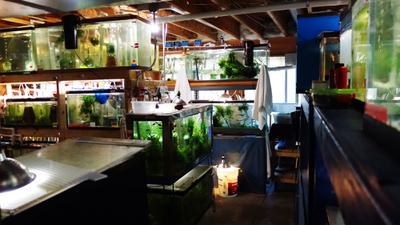
![Michael Koeck [center left] gives a tour of the 90 tanks he manages in the basement of the Haus des Meeres aquarium in Vienna.](https://yale-threesixty.transforms.svdcdn.com/production/Koeck_Bild7_web.jpg?w=400&auto=compress%2Cformat&fit=clip&dm=1740245274&s=356acb40d8590561bbabca646c6998aa)
